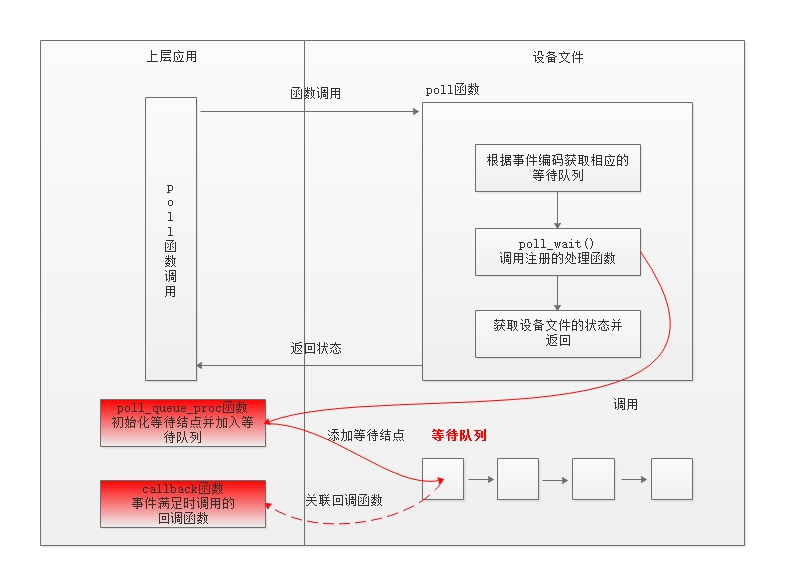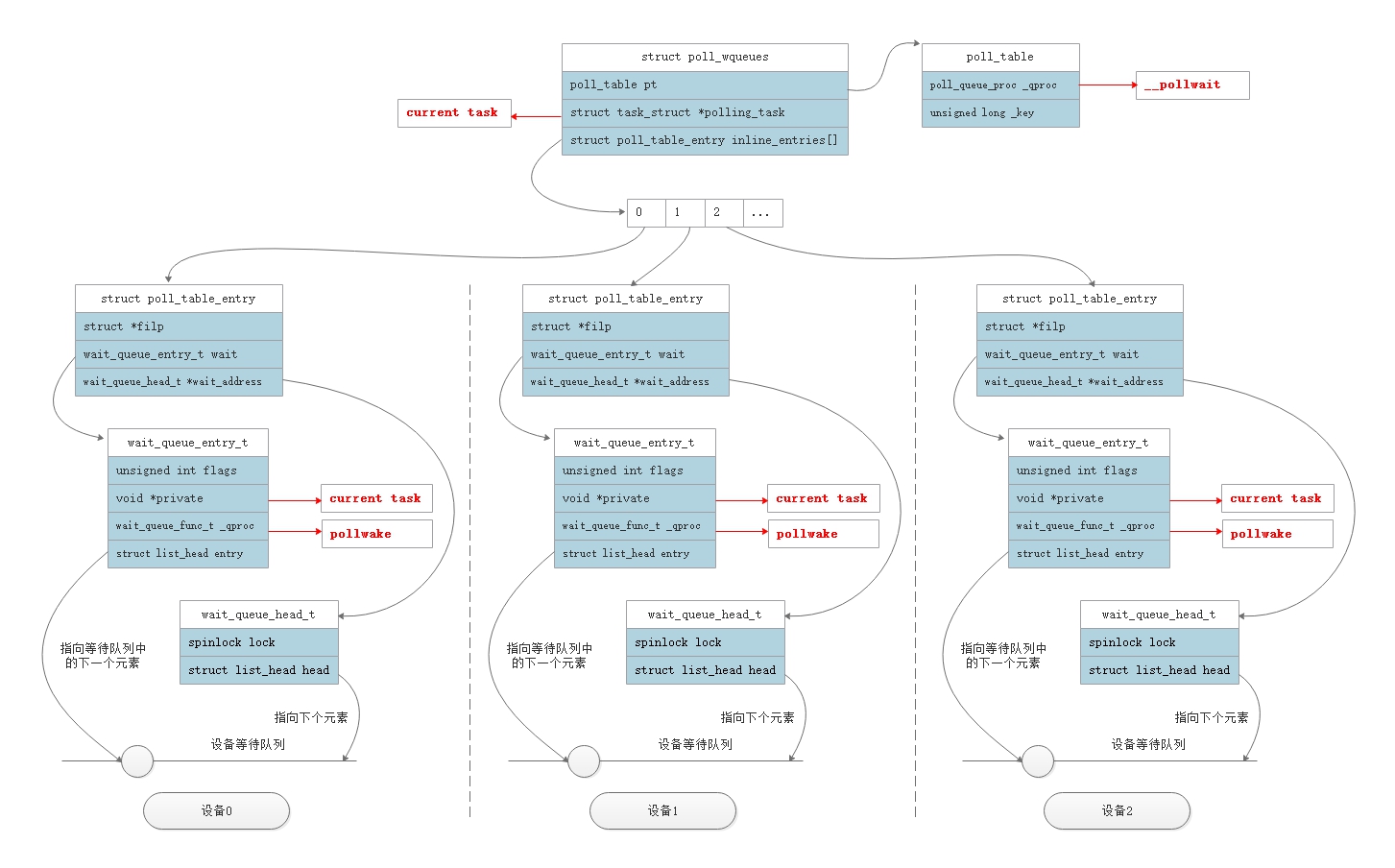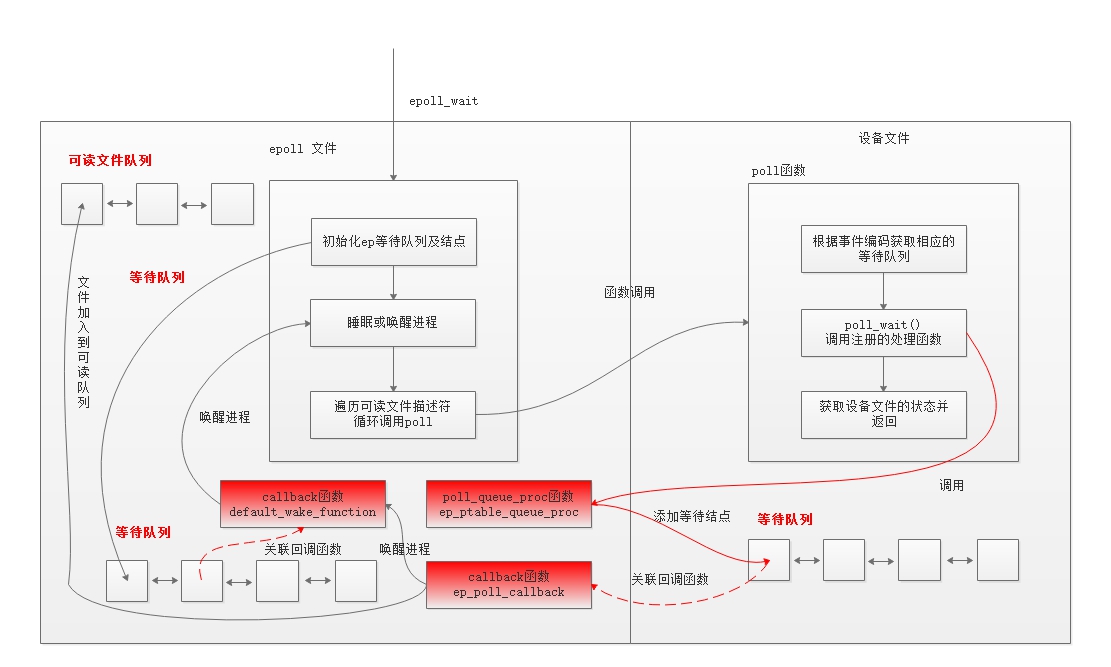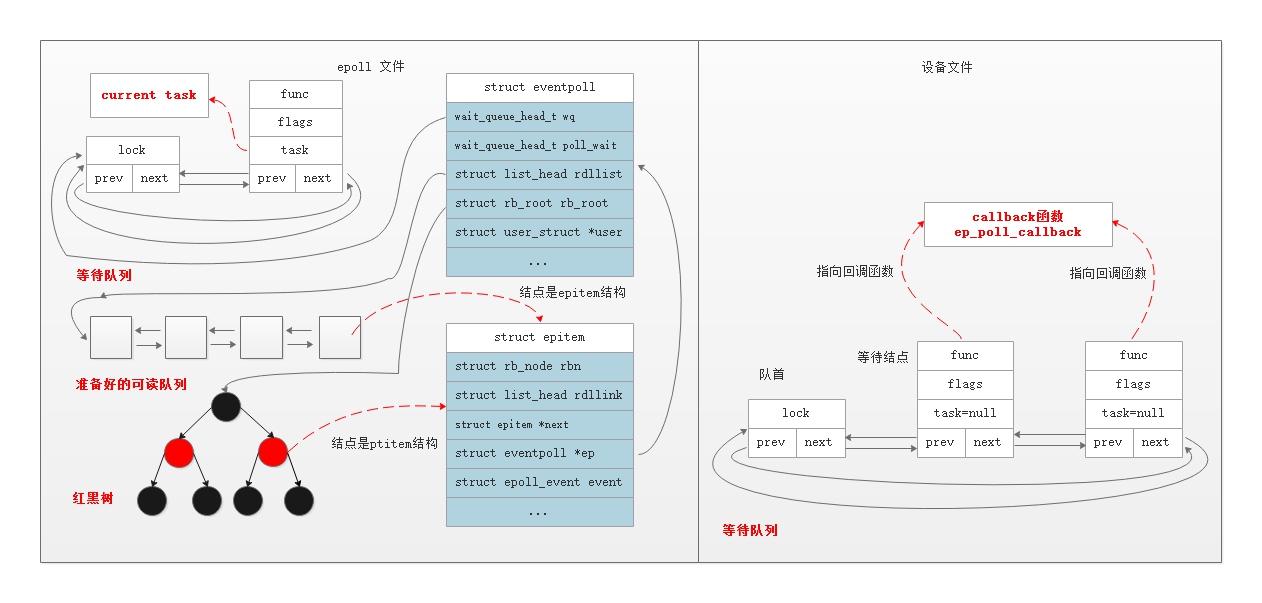这篇文章主要讲述 select 和 epoll 的实现原理,包括底层的数据结构、与设备的回调处理机制及两种实现之间的差异。
1. 知识储备
在介绍 select 和 epoll 的实现原理前,先介绍两个知识点,分别是 1)文件的 poll 函数;2)linux 的wakeup callback机制。select 和 epoll 很大程度上就是基于这两点构建的。
1.1 poll 函数
在 linux 中,设备的操作抽象为文件的操作,对网络设备的操作同样也是文件操作。为了实现非阻塞的数据读取,文件提供了 poll 操作,该操作为上层应用提供了探测设备文件是否有数据可读的接口,同时结合文件的等待队列,上层应用可以对感兴趣的事件添加处理函数,这个处理函数通常是向等待队列中添加一个等待结点,这个等待结点会关联一个 callback 函数,当相关事件满足时触发 callback 函数,最后 poll 函数返回当前设备文件的状态,上层应用根据返回状态决定是否阻塞该线程,poll 函数不阻塞线程。通过这种方式,设备文件提供了基于事件处理的回调机制,select/poll/epoll 就是基于这种方式来实现的。

poll 函数分为三个步骤:
- 获取事件对应的等待队列;
- 初始化一个等待结点,设置 callback 函数,并将等待结点加入到等待队列中,此时并不阻塞调用线程;
- 获取设备当前的状态并返回。
在 poll 函数中,上层应用可以根据业务的不同可以自定义 poll_queue_proc 和 唤醒 callback 函数,从而实现不同的功能,select/poll/epoll 分别实现了这两个函数,它们之间的差异从这两个函数中也可以看出。下面是一个 poll 函数实例。
1 | unsigned int scull_p_poll(struct file *filp, poll_table *wait) |
poll 函数的定义如下:1
2
3
4
5
6
7
8
9
10
11
12
13
14
15
16
17
18
19
20
21
// 文件操作
struct file_operations {
// 提供给 poll/select/epoll 使用,获取文件当前状态, 以及就绪通知接口函数
unsigned int (*poll) (struct file *, struct poll_table_struct *);
...
};
// 向文件注册事件及处理函数
typedef struct poll_table_struct {
// 处理函数
poll_queue_proc _qproc;
// 事件
unsigned long _key;
} poll_table;
// poll_queue_proc 函数定义
typedef void (*poll_queue_proc)(struct file *, wait_queue_head_t *, struct poll_table_struct *);
1.2 wakeup callback机制
在上节的 poll 函数中,会检查文件的状态(可读/可写/可连接),同时在事件的等待队列添加一个等待结点,待续结点中注册一个 callback 回调函数,事件触发时,再调用 callback 回调函数,唤醒结点中的 task 来处理事件。这种机制正时使用了 linux 内核 wakeup callback机制。
Linux 内核通过睡眠队列来组织所有等待某个事件的 task,而 wakeup 机制则可以异步唤醒整个睡眠队列上的 task,每一个睡眠队列上的节点都拥有一个 callback,wakeup 逻辑在唤醒睡眠队列时,会遍历该队列链表上的每一个节点,调用每一个节点的 callback,如果遍历过程中遇到某个节点是排他节点,则终止遍历,不再继续遍历后面的节点。总体上的逻辑可以用下面的伪代码表示:1
2
3
4
5
6
7
8
9
10
11
12
13
14
15define sleep_list;
define wait_entry;
wait_entry.task = current_task;
wait_entry.callback = func1;
if (something_not_ready); then
# 将任务加入等待队列
add_entry_to_list(wait_entry, sleep_list);
go_on:
# 根据情况进行睡眠或唤醒
schedule();
if (something_not_ready); then
goto go_on;
endif
del_entry_from_list(wait_entry, sleep_list);
endif
唤醒的流程:1
2
3
4
5
6
7something_ready;
for_each(sleep_list) as wait_entry; do
wait_entry.callback(...);
if(wait_entry.exclusion); then
break;
endif
done
callback 函数包含于唤醒的主要逻辑,伪代码如下所示:1
2
3
4
5common_callback_func(...)
{
do_something_private;
wakeup_common;
}
在 poll/select/epoll 中都会定义各自的 callback 函数,该函数一般包括两部分:1)私有逻辑;2)唤醒 task。callback 函数由驱动来调用(在 NIC 中由软件中断调用)。
1.3 I/O 多路复用
I/O 多路复用是一种优化技术,它是为了避免一个线程处理一个 I/O 设备文件,转而由一个线程来监听多个 I/O 文件,来提供系统的效率。poll/select/epoll 底层使用了这种 I/O 模式。
2. select
2.1 整体流程
select 方法调用:1
2
3
4
5
6
7
8
9
10
11
12
13
14
15
16
17
// 数据结构
typedef struct {
unsigned long fds_bits[__FDSET_LONGS];
} fd_set;
// select 文件调用
int select(
int max_fd, /* 最大文件数 */
fd_set *readset, /* 读事件文件集合 */
fd_set *writeset, /* 写事件文件集合 */
fd_set *exceptset,
struct timeval *timeout
); // 返回值就绪描述符的数目
从 select 方法定义来看,每次调用都需要将文件集合在用户空间及内核空间进行复制,并且文件最大的数量限制在 1024 个。组合上面的内容,可以知道 select 会定义两个函数 poll_queue_proc 和 唤醒 callback 函数,注册到 poll 函数中,在这里,这两个函数分别对应:__pollwait() 和 pollwake。其整体的流程如下所示:

select 调用主要做了三件事情:
- 初始化poll_wqueues结构,包括几个关键函数指针的初始化,用于驱动中进行回调处理;
- 循环遍历监测的文件描述符,并且调用 f_op->poll() 函数,如果有监测条件满足,则会跳出循环;
- 在监测的文件描述符都不满足条件时,会让当前进程进行睡眠,超时唤醒,或者被所属的等待队列唤醒。
select 函数的循环退出条件有三个:
- 检测的文件描述符满足条件;
- 超时;
- 由等待事件触发。
2.2 数据结构
接下来再看下 select 内部的数据结构:
在 select 方法中,会维护一个 struct poll_wqueues 结构,其中两个关键字段:
- poll_table:该结构体中的函数指针_qproc指向__pollwait函数;
- struct poll_table_entry[]:存放不同文件的 poll_table_entry,这些条目的增加是在驱动调用 __pollwait() 时进行初始化并完成添加的,每一个文件都会添加一个条目。
在这个数据结构可以看出,调用 poll 函数之后,会在所有文件的等待队列中加入一个结点,这个结点会持有当前 task 的信息,当事件触发之后,从而可以知道唤醒那一个进程;
从上面的分析可以看出,select 有以下的缺点:
- 每次 select 方法调用都会传入文件集合参数,涉及到用户空间及内核空间的两次复制;
- 每一次调用都需要遍历所有的文件调用 poll 函数,效率较低(在用户空间中,也需要遍历所有文件查看那些文件有事件触发);
- 监听的文件数量有限,最大 1024 个。
3. epoll
3.1 整体流程
epoll 解决了 select 的缺点,在大并发场景下,epoll 得到了广泛的应用,它从以下几个方面解决了 select 的缺点:
- 生成一个 epoll 文件,将监听的文件描述符加入到这个文件的数据结构(红黑树)中,只用添加一次,避免了数据的来回复制;
- epoll 文件中维护了一个可读文件队列,每次只遍历该队列,避免所有文件的遍历;
- 监听的文件不受限制。
下面我们来看下 epoll的实现原理,首先看下调用方法:
1 | // 生成一个 ep 文件,把所有需要监听的文件都放到 ep 文件中 |
epoll_create 生成一个 ep 文件,通过 epoll_ctl 方法添加/删除文件,epoll_wait 方法只遍历满足条件的可读队列,提高了效率。这三个方法大概的逻辑如下描述。
epoll_ctl 主要逻辑:
- 定义一个 epitem 结构,代表一个监听的文件,并加入到红黑树中;
- 生成一个等待结点,加入到这文件 (socket 文件)的等待队列中;
1 | define epitem |
epoll_wait 主要逻辑:
- 定义一个等待结点,将结点的 task (实际为 private 字段,为了简要描述,定义为 task) 设置为当前 task (调用 epoll_wait的进程),并设置回调函数;
- 判断当前可读队列是否为空,如果为空则将等待结点加入到 ep 文件的等待队列上,并阻塞该进程;
- 如果当前可读队列不为空,则遍历准备好的可读队列,返回数据给用户进程;
1 | define single_wait_list |
在这里需要注意的是,当前进程不像 select 方法,进程是阻塞在监听文件(socket 文件)的等待队列上,而是阻塞在 ep 文件自己的阻塞队列上,如上面的流程所述。这里有问题,如何唤醒阻塞的进程?答案在注册到监听文件的回调函数上,在 epoll_ctl 中,我们同样在监听文件的等待队列上加入了一个等待结点,当文件可读时,调用该回调函数,借助该函数,再唤醒阻塞在 ep 文件等待队列上的进程,其流程如下所述:1
2
3
4
5epoll_wakecallback(...)
{
add_this_socket_to_ready_list;
wakeup_single_epoll_waitlist;
}
在唤醒进程之前,会将该文件加入到可读队列中。
epoll_wait 流程如下图所示:
3.2 数据结构
数据结构如下所示:
关键点说明:
- 进程阻塞在 epoll 文件的等待队列上,不是监听文件的等待队列上;
- epoll 会将满足条件的文件提前放在可读文件队列 rdllist 中,减少文件遍历的数量;
- epoll 将监听的文件使用红黑树管理,可有效地进行文件的添加及删除;
- 唤醒操作由监听文件等待队列中的回调函数触发,然后再唤醒阻塞在 epoll 文件上的进程。
对应的数据结构定义为:1
2
3
4
5
6
7
8
9
10
11
12
13
14
15
16
17
18
19
20
21
22
23
24
25
26
27
28
29
30
31
32
33
34
35
36
37
38
39
40
41
42
43
44
45
46
47
48
49
50
51
52
53
54
55
56
57
58
59
60
61
62
63
64
65
66
67
68
69
70
71
72
73
74
75
76
77
78
79
80
81
82
83
84
85
86
87
88
89
90
91
92
93
94
95
96
97
98
99
100
101
102
103
104
105
106
107
108
109
110
111
112
113
114
115
116
117
118
119
120
121
122
123
124
125
126
127
128
129
130
131
132
133
134
135
136
/* 每创建一个epoll 文件, 内核就会分配一个eventpoll与之对应 */
struct eventpoll {
/* Protect the this structure access */
spinlock_t lock;
/*
* This mutex is used to ensure that files are not removed
* while epoll is using them. This is held during the event
* collection loop, the file cleanup path, the epoll file exit
* code and the ctl operations.
*/
struct mutex mtx;
/* Wait queue used by sys_epoll_wait() */
/* epoll 文件等待队列,进程就是阻塞在该队列上 */
wait_queue_head_t wq;
/* Wait queue used by file->poll() */
wait_queue_head_t poll_wait;
/* List of ready file descriptors */
/* 所有已经准备好的可读文件队列 */
struct list_head rdllist;
/* RB tree root used to store monitored fd structs */
/* 红黑树,存储所有监听的文件 */
struct rb_root rbr;
/*
* This is a single linked list that chains all the "struct epitem" that
* happened while transfering ready events to userspace w/out
* holding ->lock.
*/
struct epitem *ovflist;
/* The user that created the eventpoll descriptor */
struct user_struct *user;
};
/*
* Each file descriptor added to the eventpoll interface will
* have an entry of this type linked to the "rbr" RB tree.
*/
/* epitem 表示一个被监听的文件 */
struct epitem {
/* RB tree node used to link this structure to the eventpoll RB tree */
/* 代表在红黑树中的结点 */
union {
/* RB tree node links this structure to the eventpoll RB tree */
struct rb_node rbn;
/* Used to free the struct epitem */
struct rcu_head rcu;
};
/* List header used to link this structure to the eventpoll ready list */
struct list_head rdllink;
/*
* Works together "struct eventpoll"->ovflist in keeping the
* single linked chain of items.
*/
struct epitem *next;
/* The file descriptor information this item refers to */
/* epitem对应的文件和 struct file */
struct epoll_filefd ffd;
/* Number of active wait queue attached to poll operations */
int nwait;
/* List containing poll wait queues */
struct list_head pwqlist;
/* The "container" of this item */
/* 关联的eventpoll结构 */
struct eventpoll *ep;
/* List header used to link this item to the "struct file" items list */
struct list_head fllink;
/* The structure that describe the interested events and the source fd */
/* 当前文件关心的事件 */
struct epoll_event event;
};
/* 红黑树结点 */
struct rb_node {
unsigned long __rb_parent_color;
struct rb_node *rb_right;
struct rb_node *rb_left;
} __attribute__((aligned(sizeof(long))));
/* 红黑树根结点 */
struct rb_root {
struct rb_node *rb_node;
};
struct epoll_filefd {
struct file *file;
int fd;
};
/* Wait structure used by the poll hooks */
/* 用于构造回调函数的数据结构,在 ep_ptable_queue_proc 中使用 */
struct eppoll_entry {
/* List header used to link this structure to the "struct epitem" */
struct list_head llink;
/* The "base" pointer is set to the container "struct epitem" */
/* 关联的 epitem */
struct epitem *base;
/*
* Wait queue item that will be linked to the target file wait
* queue head.
*/
/* 添加到监听文件等待队列中的等待结点 */
wait_queue_t wait;
/* The wait queue head that linked the "wait" wait queue item */
/* 监听文件等待队列队首结点 */
wait_queue_head_t *whead;
};
/* Wrapper struct used by poll queueing */
struct ep_pqueue {
poll_table pt;
struct epitem *epi;
};
/* Used by the ep_send_events() function as callback private data */
struct ep_send_events_data {
int maxevents;
struct epoll_event __user *events;
};
4. 总结
通过对 select 及 epoll 方法的分析,可以知道,epoll 从各个方面进行了优化,相对 select, 在大部分场景下,性能有了质的飞跃,这也是网络中间件中大部分选用 epoll 的原因。
参考:
1. Linux select/poll/epoll 原理(一)实现基础
2. inux驱动—file_operations之poll
3. Linux select/poll机制原理分析
4. Linux内核中网络数据包的接收-第二部分 select/poll/epoll
5. 从linux源码看epoll
6. 高性能网络编程5–IO复用与并发编程
7. epoll源码分析
8. 带您进入内核开发的大门 | 内核中的等待队列